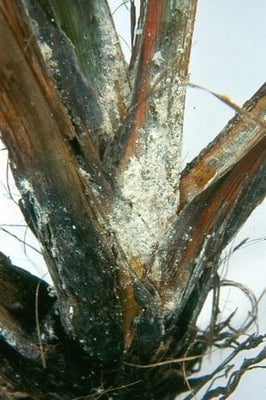
Quick facts
Common name - Phormium mealybug
Scientific name - Balanococcus diminutus
Plants affected - New Zealand flax, Phormium
Main symptoms - Fluffy white wax, honeydew and sooty moulds
Most active - Year round
What is phormium mealybug?
Phormium mealybug is only found on Phormium and like the host plant originates from New Zealand, it is able to survive British winters out of doors. Most other mealybugs found in Britain are dependent on glasshouse conditions. Mealybugs are sucking true bugs. They excrete excess sugars as honeydew this lands on the leaves and stems were it is often colonised by sooty moulds , giving the surfaces a blackened appearance.
This species of mealybug tends to cluster around the base of leaves. On young plants large populations can cause plants to lack vigour and foliage may die prematurely. Older seem to be more tolerant of this insect and will often survive without obvious damage.
Management
In most cases this insect needs to be tolerated. Being an introduced species it has few natural enemies. It is a very difficult insect to manage as the mealybugs are concealed at the base of leaves or where leaf margins are folded together.
- can often tolerate populations of Phormium mealybug
- When purchasing a Phormium examine it carefully and reject any that shows signs of mealybug. A plant free of mealybug is likely to remain in that condition as this insect cannot fly and there is little opportunity for it to spread from other gardens in Britain
- The biological controls available for glasshouse mealybugs are unlikely to manage phormium mealybug as they require the warmer temperatures in glasshouses to be effective
- Consider replacing heavily affected plants


